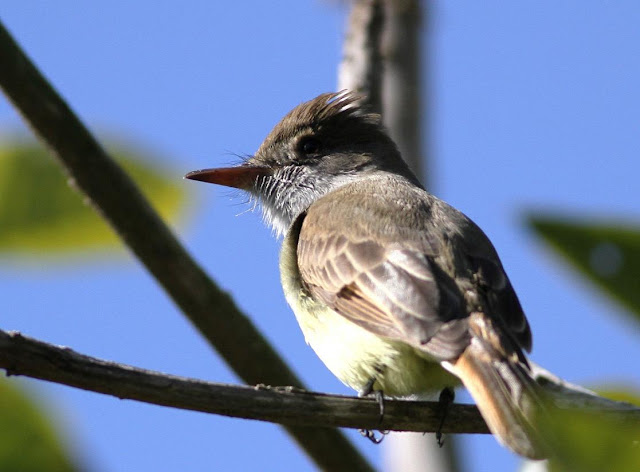Eve had mentioned the other day that she had seen the rare
Dusky-capped Flycatcher at the San Diego Botanic Garden. Decided to go and see
if I might be lucky enough to get a few shots of the bird that is causing such a
big sensation at the garden!
As soon as I drove into the parking area, I noticed a group of
birders gathering in the north area of the parking lot. Lol, easy to tell the
birders from the regular visitors! Most have binoculars or scopes or a bird guide
book with them. In the middle of the group, I recognized the leader as Steve
Brad of Buena Vista Audubon Society. This is great, there will be many eyes looking for the flycatcher today!
Walking quickly to the tropical fruit tree area, I was delighted to hear many
calls and see movements in most of the plants. Here is my first subject as I
scanned the trees for birds: a Bewick's Wren.
Wow, a Western Tanager shows up and he has a fruit cluster
in his beak. The red coloring on the head shows that this is a male. He is in non-breeding
plumage. The male will have a bright red head when in full breeding plumage.
A close-up of the male tanager with a cluster of mulberry fruit.
A good look at his wing markings.
The front view. Western Tanager, Piranga
ludoviciana measures 7.25 inches long with a wingspan of 11.5
inches.
A Townsend's Warbler on a nearby fruit tree peeks
through the branches.
It wasn't long before someone in Steve's birding
group spotted the Dusky-capped Flycatcher. Here is my first shot of this rare visitor to the garden.
A side view.
Dusky-capped Flycatcher, Myiarchus
tuberculifer measures 7.25 inches long with a wingspan of 10
inches.
A cute pose.
A look at his underside.
Close-up of his head. A look at the whiskers.
Look at his under chin.
Raised crown.
Close-up.
A look at the dusky-colored crowned head.
Nice side view.
A nice pose by the Dusky-capped Flycatcher showing
the inconspicuous wingbars.
A good look at his handsome head.
Rufous edges on the tail.
Look at the flycatcher bill.
A good look at his back.
One more shot and it's time to check out the rest of
the garden.
Just as I am walking out of the tropical plant area, I
notice this little guy looking for bugs in the shade.
Ruby-crowned Kinglet, Regulus
calendula measures 4.25 inches long with a wingspan of 7.5
inches.
One last look at the kinglet.
As I walk towards the garden gift shop, I pass a tree with
a raptor swooping onto a prey. It's a male American Kestrel!
He grabs his prey and circles the tree.
You can see the prey is a lizard with a chopped
tail.
He lands back on the tree and starts to eat.
A look at the Kestrel eating his prey. I walk past and
go towards the tropical plant area.
Walking towards the small waterfall and pond, I spot a
Song Sparrow posing on top of an artwork display.
The sparrow is perched on the headdress of a warrior
statue, one of many sculptures displayed in the garden.
Looking west from the road, I see the male American Kestrel
flying in. He lands on a large stump of a tree that is approximately 15 ft in
height. It's the same Kestrel that was by the gift shop. He lands and walks
across the table.
He strolls across the table of the large tree stump.





































No comments:
Post a Comment